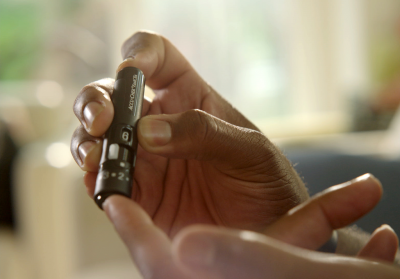START THE DAY OFF RIGHT
It’s a fact: breakfast is the most important meal of the day. In addition to providing you with the energy you need, it helps you keep hunger under control and prevent drops in blood sugar… as long as you limit carbohydrate and fat intake in favor of protein and fibre. Low on time or ideas in the morning? Here’s some inspiration!...
Read MoreSelf-monitoring of your diabetes
Diabetes is part of your everyday life. Appropriate self-monitoring can help you manage your daily blood glucose, and better adapt your lifestyle and treatment to suit your needs.1 The more often you check your blood glucose, the better you will understand it and the easier it will be for you to manage your diabetes. It doesn’t matter if you have type 1 or type 2 diabetes, or if you are taking insulin or not, self-monitoring can help you and your doctor manage your therapy.2 By managing your diabetes, you reduce the risk of developing complications. That means potentially less eye, kidney and...
Read MoreHow to make sense of blood sugar numbers
I don’t understand what my blood sugar range means! If you live with diabetes, you have probably been asked to check your blood sugar a lot. But what are you supposed to be checking? How do you make sense of the numbers you see? Managing your diabetes is easier when you know what the numbers mean and what you are trying to accomplish....
Read MoreKnowing My Numbers ... Diabetes Management Numbers Explained
When you’re trying to manage your diabetes, it’s all about the numbers. While you might immediately think about your daily blood sugar numbers, there are additional numbers to know. By keeping track of important numbers, you lower your risk of serious complications in the future. What numbers do you need to know? What do they mean? What should your numbers be? Here’s a closer look at the most important diabetes management numbers you’ll want to track. Daily Blood Sugar Numbers Daily blood sugar checks help you see how well you’re managing your diabetes...
Read MoreBLOOD SUGAR TEST RESULTS HELP YOU TAKE CONTROL
Testing your own blood sugar helps you take control of your health, especially once you learn what your test result numbers mean, and what to do with them. The Structured Testing Protocol (STeP) study, offers the proof. The study concluded that collecting the data of blood sugar test results, visualizing and understanding this data, and focusing treatment based on that data significantly reduced the HbA1C levels of poorly controlled type 2 diabetes over a 12-month period1....
Read More5 ways to manage your blood sugar while working from home
Making the shift from being an in-office employee to one who works remotely can certainly be an adjustment. You may need to learn how to balance your own conference calls, create boundaries between your family time and late-night requests from colleagues when there’s no commute separating the spheres of your life and focus on that quarterly report when there are piles of laundry staring you in the face. Working from home presents a whole different set of challenges for people with diabetes....
Read More4 TIPS FOR VIRTUALLY PAIN-FREE FINGER PRICKING
Lancing or pricking fingers is a vital part of your daily diabetes management. Finger soreness and pain were the most common reasons for people living with diabetes to refrain from regular blood glucose testing1. Lancing correctly with Accu-Chek ®...
Read MoreSelf-monitoring of your diabetes
Diabetes is part of your everyday life. Appropriate self-monitoring can help you manage your daily blood glucose, and better adapt your lifestyle and treatment to suit your needs.1 The more often you check your blood glucose, the better you will understand it and the easier it will be for you to manage your diabetes. It doesn’t matter if you have type 1 or type 2 diabetes, or if you are taking insulin or not, self-monitoring can help you and your doctor manage your therapy.2 By managing your diabetes, you reduce the risk of developing complications. That means potentially less eye, kidney and...
Read MoreHow to make sense of blood sugar numbers
I don’t understand what my blood sugar range means! If you live with diabetes, you have probably been asked to check your blood sugar a lot. But what are you supposed to be checking? How do you make sense of the numbers you see? Managing your diabetes is easier when you know what the numbers mean and what you are trying to accomplish....
Read MoreKnowing My Numbers ... Diabetes Management Numbers Explained
When you’re trying to manage your diabetes, it’s all about the numbers. While you might immediately think about your daily blood sugar numbers, there are additional numbers to know. By keeping track of important numbers, you lower your risk of serious complications in the future. What numbers do you need to know? What do they mean? What should your numbers be? Here’s a closer look at the most important diabetes management numbers you’ll want to track. Daily Blood Sugar Numbers Daily blood sugar checks help you see how well you’re managing your diabetes...
Read MoreBLOOD SUGAR TEST RESULTS HELP YOU TAKE CONTROL
Testing your own blood sugar helps you take control of your health, especially once you learn what your test result numbers mean, and what to do with them. The Structured Testing Protocol (STeP) study, offers the proof. The study concluded that collecting the data of blood sugar test results, visualizing and understanding this data, and focusing treatment based on that data significantly reduced the HbA1C levels of poorly controlled type 2 diabetes over a 12-month period1....
Read More5 ways to manage your blood sugar while working from home
Making the shift from being an in-office employee to one who works remotely can certainly be an adjustment. You may need to learn how to balance your own conference calls, create boundaries between your family time and late-night requests from colleagues when there’s no commute separating the spheres of your life and focus on that quarterly report when there are piles of laundry staring you in the face. Working from home presents a whole different set of challenges for people with diabetes....
Read More4 TIPS FOR VIRTUALLY PAIN-FREE FINGER PRICKING
Lancing or pricking fingers is a vital part of your daily diabetes management. Finger soreness and pain were the most common reasons for people living with diabetes to refrain from regular blood glucose testing1. Lancing correctly with Accu-Chek ®...
Read More






